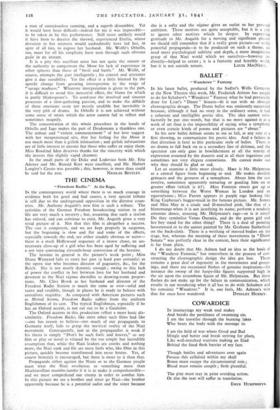BALLET
" Wanderer " Fantasy
IN his latest ballet, produced by the Sadler's Wells Company at the New Theatre this week, Mr. Frederick Ashton has sought to do for Schubert's " Wanderer " Fantasy what he had previously done for Liszt's " Dante " Sonata—fit it out with an abstract choreographic design. The Dante ballet was eminently successful because, although it had no story in the ordinary sense, it had a coherent and intelligible poetic idea. The idea cannot satis- factorily be put into words, but that is no more against it as a work of art than is the impossibility of saying what a symphony or even certain kinds of poems and pictures are "about."
In his new ballet Ashton seems to me to fail, at any rate at a first showing, to communicate his poetic idea. And a failure in that direction is fatal tO this particular style of ballet. There is no drama to fall back on as a secondary line of defence, and the spectator can only gaze in bewilderment at all the tensity of expression assumed by the dancers and at all their ingenious and sometimes not very elegant contortions. He cannot make out why they should be glad or sad.
Let us examine a little more closely. Hare is Mr. Helpmann as a central figure from beginning to end. He makes devilish grimaces and the gestures of a semaphore. About him the rest revolve, sometimes apparently torturing or goading him on to greater effort (which is it?). Miss Fonteyn enters got up as something between the Worst Woman in London and an equestrienne ; Miss Farren appears in purple rags looking like King Cophetua's beggar-maid in the famous picture. Mr. Somes and Miss May in a crude and ill-matched pink, like that of a blancmange when it is not justifying its name, perform a tenderly amorous dance, arousing Mr. Helpmann's rage—or is it envy? Do they symbolise Venus Ourania, and do the green girl and her boy stand for the other thing? There is a deal of pointing heavenward or to the sunset painted by Mr. Grahame Sutherland on the back-cloth. There is a writhing of massed bodies on the stage, but, whereas the meaning of these movements in "Dante Sonata" was perfectly clear in the context, here their significance is far from plain.
I do not doubt that Mr. Ashton had an idea as the basis of the "Wanderer Fantasia," but somewhere in the process of con- structing the choreographic design the idea got lost. There remains a great deal of ingenuity in the movements and group- ings, and there are occasional flashes of genuine inspiration—for instance the swoop of the harpy-like figures supported high in the air upon the recumbent figure of Mr. Helpmann. But these flashes do not make up for the failure in communication, which results in our wondering what it all has to do with Schubert and his romantic "Wanderer." It is, one feels, Mr. Ashton's wits






























 Previous page
Previous page